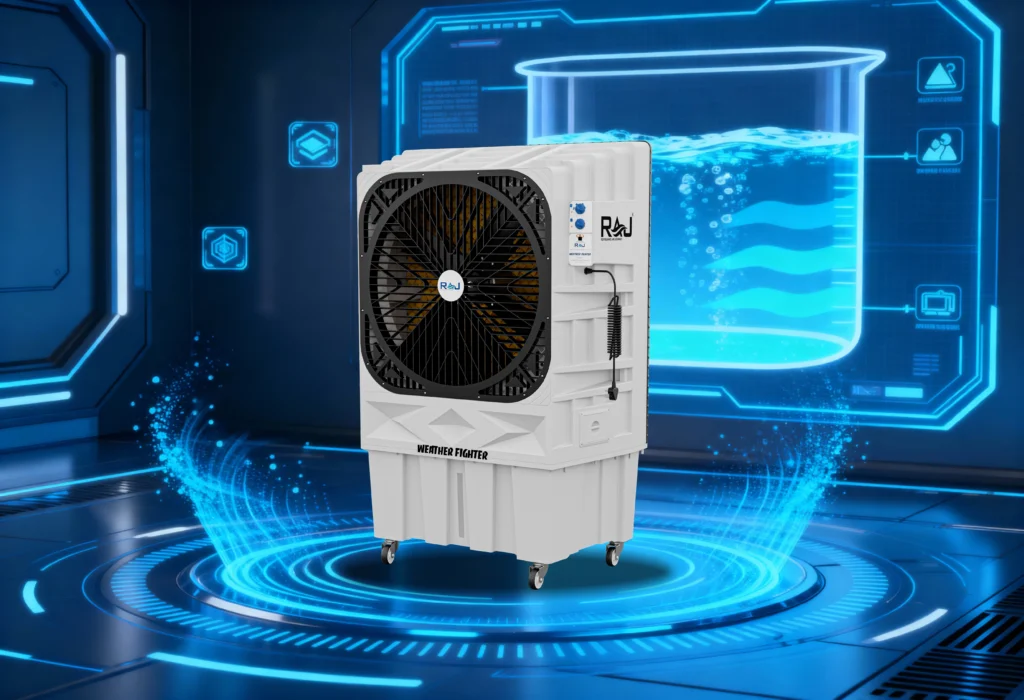Air coolers have long been trusted in Indian households, offices, and commercial spaces for their affordability and natural cooling experience. As evaporative cooling systems, they rely on water to deliver consistent and refreshing airflow, making the water tank size a crucial factor in determining how well they perform. The tank capacity directly affects cooling duration, the strength of airflow, and how frequently the cooler needs attention from the user. Whether it’s a compact room cooler or a large desert model, understanding how tank size aligns with your space and usage needs can help you choose a cooler that offers better comfort, efficiency, and long-term convenience.
Understanding the Role of Water in Air Cooling
To understand the importance of tank capacity, it’s crucial to know how evaporative cooling works. Air coolers draw warm air from the surroundings, pass it through water-soaked cooling pads, and release cooled air into the room. As water evaporates, it absorbs heat from the air, naturally lowering the temperature. This process depends on continuous water supply and proper cooling pad saturation, meaning the cooler must always have enough water for effective operation.
If the water level drops, cooling pads dry out, reducing cooling depth, airflow quality, and efficiency. This makes water not just a supporting component but the primary fuel of the air cooler. Larger water tanks ensure longer running cycles and more effective evaporation making the cooling experience steady and enjoyable.
How Water Tank Size Affects Cooling Performance
The tank capacity significantly influences cooling strength, duration, and stability in daily use.
A bigger water tank allows the cooler to run for long hours without interruption. This is especially important during hot summers when you need cooling through the day and night. Users of small coolers often face the inconvenience of frequent refills, especially in high-temperature climates where evaporation rates are faster.
A large tank supports more consistent airflow by ensuring the pads remain fully soaked. When pads stay saturated for extended periods, the cooler produces deeper, more refreshing airflow. Conversely, when a small tank runs low on water, airflow can become warm and weak.
Tank size also determines cooling depth, as fully saturated pads provide maximum surface area for evaporation. A cooler with a 50–100 liter tank, for example, offers significantly better pad saturation and cooling intensity compared to models with 10–20 liter tanks. Thus, tank size directly contributes to cooling performance and user comfort.
Efficiency and Power Consumption
Water tank size has a surprisingly strong impact on energy efficiency as well. A cooler with a large tank maintains steady performance throughout the day without forcing the motor or pump to work excessively. Since the evaporative process remains uninterrupted, the cooler operates smoothly and consumes predictable amounts of electricity.
A cooler with a small tank may experience frequent dry-pump cycles, which strain the pump, reduce cooling efficiency, and increase power usage over time. Larger tanks also reduce the number of times the user needs to refill water, saving effort and minimizing downtime. In commercial settings, this ensures uninterrupted productivity and reliable cooling performance. Ultimately, a well-sized tank supports optimal air cooler efficiency and lowers long-term operating costs.
Water Tank Size and Room Requirements
Choosing the right tank size depends heavily on where the cooler will be used. For small bedrooms or personal spaces, a mini cooler with a 10–20 liter tank may be sufficient for a few hours of use. However, for larger rooms, halls, office spaces, or outdoor events, a desert cooler tank capacity of 50 liters or more becomes essential to ensure adequate coverage and long cooling cycles.
In industrial environments, tanks often exceed 100–200 liters because the cooling space is large, and air coolers need to run continuously during working hours. Outdoor areas such as event tents, restaurants, and workshops also require large-capacity tanks to match high evaporation rates due to heat and airflow exposure. Matching tank size with room size helps achieve the ideal balance between cooling strength and convenience.
Maintenance Impact
Water tank size also affects how often you need to clean the cooler. Larger tanks accumulate sediment and mineral deposits over time, especially if hard water is used. This may require less frequent but deeper cleaning. Smaller tanks need more frequent refilling, which may result in quicker dirt buildup.
However, since larger tanks reduce the number of refills, the user has fewer touchpoints with the water system minimizing contamination risks when maintained properly. A well-sized tank also protects cooling pad saturation, extending the pads’ lifespan and preventing dry patches that lead to uneven cooling. Proper hygiene and tank maintenance ensure the cooler operates smoothly and efficiently.
Benefits of Large vs. Small Tanks
Both large and small tanks have their advantages depending on usage patterns. Coolers with larger tanks are ideal for long-term operation, bigger rooms, and high-heat environments. They provide uninterrupted cooling, deeper pad saturation, and reduced refill effort. However, they are heavier and require more space.
Small tanks, on the other hand, are suitable for compact rooms or personal use. They consume less water and are easier to move. But they need frequent refills and may not maintain cooling consistency in hot climates. Understanding your lifestyle and room size helps determine which tank size offers the best comfort and value.
Innovations in Water Tank Design
Modern coolers come with advanced tank features that improve performance and convenience. Many models now include auto-fill systems, allowing users to connect the cooler to a continuous water source for hassle-free operation. Water level indicators help users track consumption, while overflow protection prevents spills.
Some brands offer anti-bacterial tanks made from special materials that reduce microbial growth and maintain hygiene. Large-capacity desert coolers also feature wide tank openings for easier cleaning and maintenance. These innovations make water management easier and enhance overall air cooler performance.
Brands and Model Variations
Several reputable brands offer coolers with tank sizes suited for different needs. Raj Cooling Systems, known for its durable engineering and powerful airflow designs, offers a variety of coolers with large tank capacities ideal for homes, events, and industrial usage.
Brands like Symphony, Bajaj, and Crompton also provide excellent tank options ranging from compact personal coolers to heavy-duty desert models. Choosing a reliable brand ensures better efficiency, consistent cooling, and long-term value.
Conclusion
Water tank size plays a vital role in an air cooler’s performance, cooling strength, efficiency, and convenience. From airflow consistency to maintenance needs, the right tank capacity enhances overall cooling experience and helps users enjoy continuous, reliable comfort. By understanding tank size requirements for each space whether small rooms or large industrial setups buyers can make smarter decisions that ensure maximum value. For those seeking powerful cooling with dependable tank designs, brands like Raj Cooling Systems offer some of the best large-capacity solutions in the market.

